In gardens on personal plots, you can see many varieties of trees, which are carefully and lovingly cared for by gardeners. And invariably in each of them there is a cherry, delighting with abundant flowering in spring, and in summer, bringing joy with sweet and sour tasty berries. Cherry Vladimirskaya is the most common and unpretentious variety, which is in great demand among gardeners.
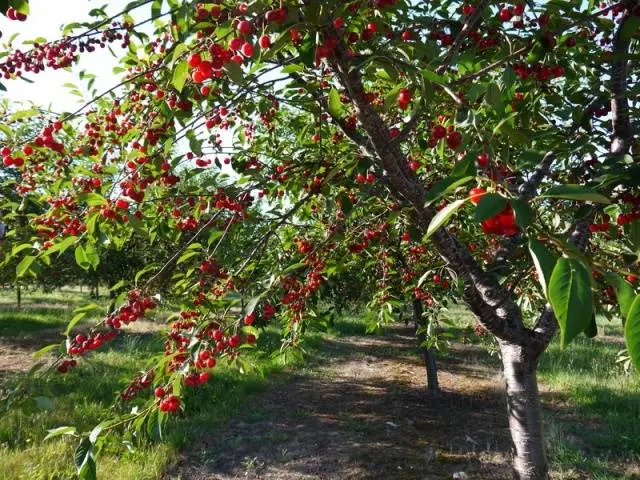
Photo of Vladimirskaya cherry tree.
History of breeding
Greece is considered the birthplace of cherries. It was brought to the Vladimir province by monks making a pilgrimage. This event took place in the XII century.
The name of the variety Vladimirskaya comes from the city of Vladimir, around which the son of Yuri Dolgoruky ordered to plant cherry orchards. The Vladimirskaya cherry variety was zoned in 1947, and since then has won a firm place in the gardens and hearts of ordinary gardeners.
Description of the culture
The grafted Vladimirskaya cherry has the appearance of standard trees with a round crown up to 5 m high, but grown from the undergrowth, it forms sprawling bushes from 3 m high.
The life span of the Vladimirskaya cherry is on average about 17 years. The trunk and branches are covered with dark gray bark with longitudinal cracks; over time, it peels off and exfoliates. On young branches, the bark has a yellowish or brick color, they are slightly lowered down, and it is on them that the fruits are located.

The leaves of the Vladimirskaya variety are dark green, matte, about 80 cm long, have an elongated shape, and are, as it were, folded along a vein that runs along the center of the leaf. The tip is pointed, there are small notches along the edges of the leaf plate. With the shoots, the leaves are connected by a strong stalk, which has a slight reddish tint.
Cherry flowers of this variety are collected in 5-7 pieces. in dense inflorescences. A flower with a diameter of about 3 cm consists of five white petals, slightly forked at the tips. Pistils and stamens are somewhere on the same level.
In the Vladimirskaya variety, the berries are medium-sized, rounded, slightly compressed at an almost imperceptible lateral seam, and with a slight indentation at the petiole. The diameter of the berry is up to 2 cm, and the weight of the fruit is about 3 g. The skin is dark red in color, with barely visible gray spots.
The pulp of the berries of the Vladimirskaya variety is juicy, fibrous structure, maroon in color. In the center of the fruit is a small brown bone, which is quite easily separated from the fruit. The length of the petiole connecting the berry to the branch does not exceed 5 cm.
Features
Cherry Vladimirskaya refers to mid-season varieties. The taste and quality of berries depends on the region and growing conditions.
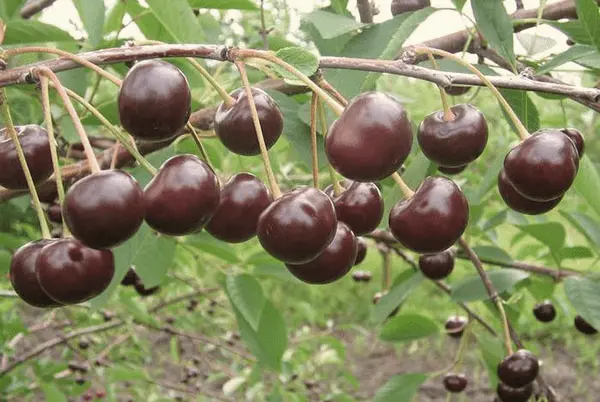
Drought resistance, winter hardiness, in which region can be grown
In arid regions, the Vladimirskaya variety cannot be grown because of its love of moisture. The frost resistance of this variety is good, but generative buds are damaged during severe frosts. This prevents the spread of the Vladimirskaya variety in areas north of the middle zone.
But the tree feels great in the conditions of the central regions of Our Country, located in the middle lane. In the Moscow region, for example, the Vladimirskaya variety is very common. After all, planting and caring for Vladimirskaya cherry in the Moscow region does not require additional efforts, since this area also belongs to the central regions.
Pollinators, flowering and maturation period
The Vladimirskaya cherry variety is self-fertile, it needs pollinators of 2-3 varieties. Therefore, he needs a neighborhood of cherries of a certain variety:
- Rastunya;
- Amorel pink;
- Turgenevka;
- Zhukovskaya;
- Vasilievskaya;
- Lyubskaya;
- Morel black.
Flowering variety Vladimirskaya begins in early May. From the appearance of the first flowers to the ripening of berries, about 60 days pass.

yield, fruiting
The grafted Vladimirskaya cherry begins to bear fruit no earlier than 2 years after planting; for ungrafted trees of this variety, the period increases to 4-5 years. In the central zone of the country, more than 20 kg of cherries are harvested from one tree of the Vladimirskaya variety.
Scope of berries
Berries of the Vladimirskaya variety are readily used in cooking. Many wonderful dishes are prepared from them:
- Pies;
- Vareniki;
- Strudels;
- Jam;
- compotes;
- Sauces;
- syrups;
- Punches, liqueurs, cognacs.
Cherry fruits of this variety are widely used in official and folk medicine. They have antiseptic, sugar lowering, expectorant and laxative properties.
Advantages and disadvantages
The advantages of Vladimirskaya cherries have been tested for years. But, of course, there are also small disadvantages.
Advantages | Disadvantages |
High yield | Self-infertility |
Unpretentiousness | Low frost resistance of generative buds |
Winter hardiness | Tendency to fungal diseases |
Great tasting berries |
|
Wide range of uses |
|
Good fruit transportability |
|
Features of landing
To achieve a good harvest of berries, you need to take into account all the nuances of planting Vladimirskaya cherries. After all, there are no trifles in such an important matter.
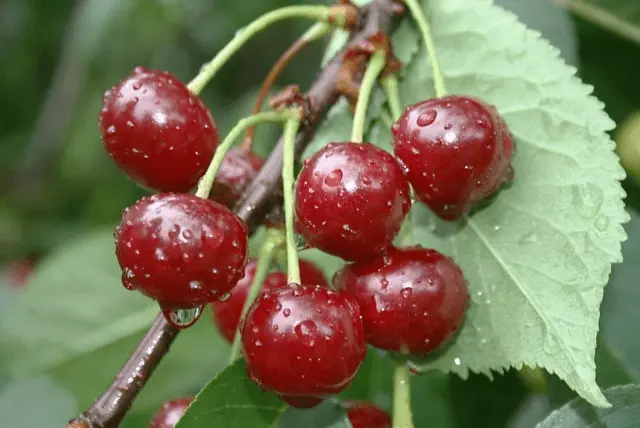
Deadlines
In the central regions of Our Country, Vladimirskaya cherries are planted in April, when the earth has already warmed up, but the buds have not yet blossomed.
In the south, the Vladimirskaya variety is planted in September, as in summer the intense heat has a bad effect on the seedlings.
Site Selection
When planting Vladimirskaya cherries, it is advisable to choose places protected from the wind and well lit. The best option would be the southern or western part of a low hill. The most suitable soil for planting cherries of this variety is chernozem or loam. On flat areas, cherries are also planted, but this slightly slows down its development.
What crops can and cannot be planted next to the Vladimir cherry
Cherry Vladimirskaya does not tolerate the neighborhood of such trees and bushes:
- Pear;
- Apple tree;
- Black currant;
- Red rowan;
- Raspberries;
- They stuck;
- Gooseberry.
The best neighbors for her are:
- Cherries (without which pollination is impossible);
- Plums;
- Cherry plum;
- Elderberry;
- Grapes;
- Rowan.
The right choice of plant neighbors in the garden is very important for increasing the yield.
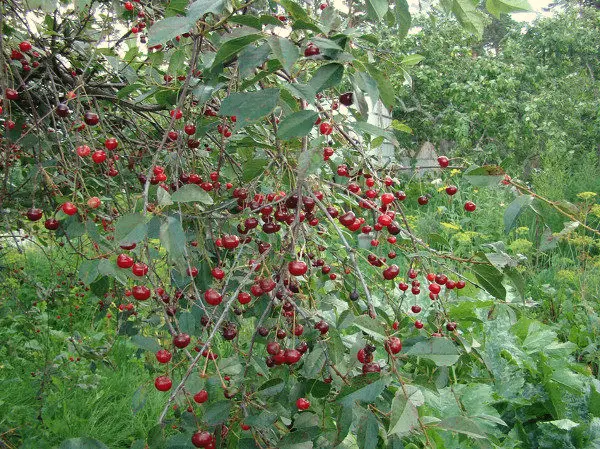
Selection and preparation of planting material
Planting material can be grown by yourself, or can be purchased at a nursery. The main thing is that the seedling does not have signs of disease, there are no cracks on the bark, and the roots are branched, at least 30 cm long and without damage. Preference is given to annual plants.
Landing algorithm
The technology for planting cherries of this variety is simple:
- Dig a hole with a depth of 0,6-0,9 m.
- Drive a peg 1,5 m long.
- A mound about 25 cm high is made in the center.
- A seedling is placed on the tubercle and the roots are straightened.
- Sprinkle with fertile soil, carefully tamping.
- The root neck is placed 4-6 cm above the soil.
- Around the hole make a small elevation of the earth in the form of a roller.
- For watering in several approaches, use 2-4 buckets of water.
- The seedling is loosely tied to a peg.
- The earth is mulched with sawdust, humus or peat.
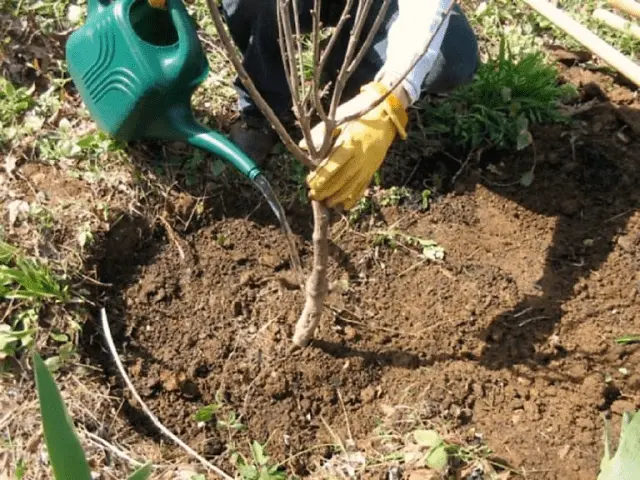
Culture aftercare
The subsequent care of this variety of cherries is simple, and consists of simple steps:
- pruning;
- watering;
- top dressing;
- disease prevention;
- Pest control;
- Preparing cherries for winter.
Pruning and shaping the crown is best done in the spring. But the Vladimirskaya cherry does not need too frequent watering. During the season, 5-9 buckets of water are used, the amount depends on the age of the tree.
For autumn top dressing, organic substances are used (manure, compost, sawdust). In the spring, ash and phosphate fertilizers can be used.
In winter, it is better to wrap the trunk and lower branches of the tree with dense material to protect against frost and possible attack by rodents.
Diseases and pests, measures to combat them
Cherry Vladimirskaya, unfortunately, is prone to fungal diseases. But timely intervention will not allow this factor to affect the crop.
Disease | Symptoms | Control measures |
Moniliasis | Burn spots appear on leaves and branches. The affected parts are covered with gray growths. The growth of growths, leading to the death of foliage, branches, berries. | Treatment of plants and soil with Bordeaux liquid, it is also possible with iron or copper sulfate. Parts of the plant with signs of damage are destroyed in the fire. |
Kokkomikoz | The appearance of red dots on the leaves, turning into spots. The leaves turn yellow and fall off, the berries dry up.
| Preventive spraying with fungicides or Bordeaux liquid. Timely pruning. Cleaning up fallen leaves. |
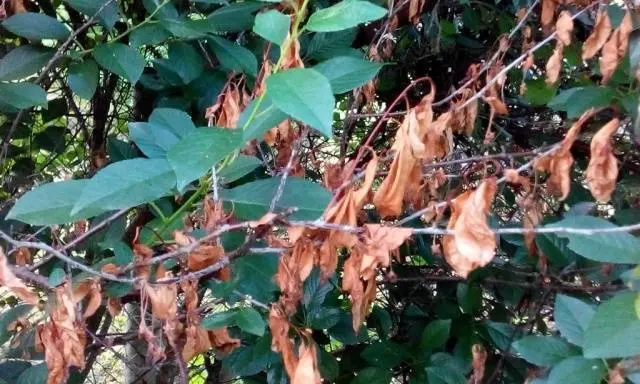
No less than diseases of the Vladimirskaya variety cherries are annoyed by pests:
vermin | Evidence | Control measures |
cherry shoot moth | Drying of leaves and buds | During the appearance of the kidneys, treatment with Iskra. After flowering, treatment with Kinmiks. |
cherry aphid | Curled and withered leaves | Preventive measures in the form of loosening and weeding. Treatment of cherries with insecticides. |
Mice | Damage to the bark at the base of the trunk | Creating a barrier from plants not loved by rodents (garlic, imperial hazel grouse, black root). Traps for mice. Binding of trunks at the base with protective material. |
Conclusion
Vladimir cherry is in demand both in amateur and industrial gardening. It is quite suitable for beginner gardeners as a first experience. And for the warmth and care he will thank with a plentiful harvest of delicious berries.
A few tips from the author of the video:









